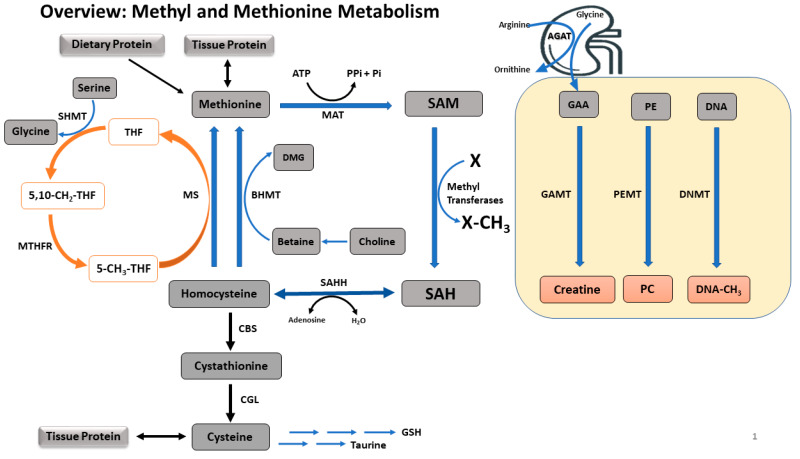Figure 1.
A summary of methyl and methionine metabolism. Methionine is an ubiquitous amino acid acquired via tissue protein breakdown or dietary intake. Methionine is converted to SAM via irreversible adenosylation, which is used for transmethylation. Utilizing methyl groups from SAM, DNA, GAA, PE, glycine, and a number of other transmethylation precursors are transmethylated to methylated DNA, creatine, PC, sarcosine and other products, respectively. These transmethylation reactions are governed by the dietary availability of methionine, choline, betaine, and serine (via folate cycle) which are the primary methyl donors. The common end product of all transmethylation reactions is SAH, which is then converted to homocysteine. Homocysteine is either irreversibly oxidized to cysteine via the transsulfuration pathway or remethylated to methionine via BHMT or MS. Enzymes involved in methyl metabolism are: MAT, methionine adenosyltransferase; GAMT, guanidinoacetate methyltransferase; PEMT, phosphatidylethanolamine methyltransferase; DNMT, DNA methyltransferase; SAHH, S-adenosylhomocystine hydrolase; CBS, cystathionine beta-synthase; CGL, cystathionine gamma-lyase; BHMT, betaine-homocysteine methyltransferase; MS, methionine synthase; SHMT, serine hydroxymethyltransferase; MTHFR, methylenetetrahydrofolate reductase. Metabolite abbreviations: SAM, S-adenosylmethionine; SAH, S-adenosylhomocysteine; GAA, guanidinoacetic acid; PE, phosphatidylethanolamine; PC, phosphatidylcholine; DMG, dimethylglycine; THF, tetrahydrofolate; 5,10-CH3-THF, 5,10-methylenetetrahydrofolate; 5-CH3-THF, 5-methyltetrahydrofolate.

